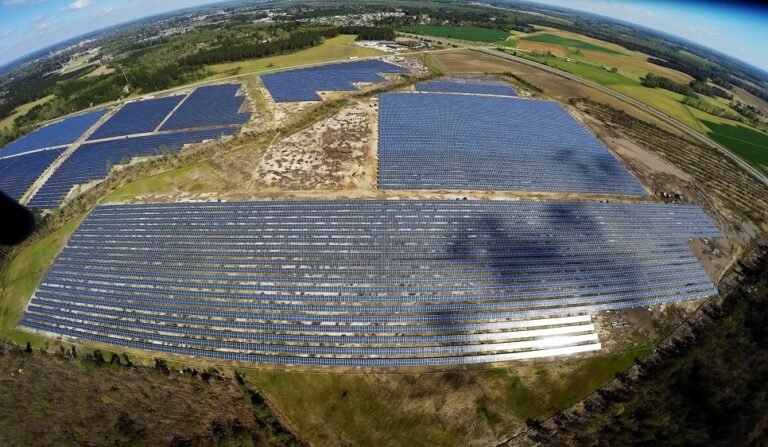-
2103 Room NO.322 Xinggang One Road, Haicang District, Xiamen Fujian, China

Screw Pile Pull-out Strength Test: Overview and Importance for Solar Projects
Table of Contents
Screw piles are commonly used as the foundation for solar power plants. To ensure their suitability and long-term performance, a pull-out strength test should be conducted before construction. This test helps avoid unnecessary expenses, structural failure, and delays.
In this article, we’ll explain:
- What the pull-out test involves,
- Why it’s necessary,
- The types of testing available,
- And why such tests are becoming more widespread in solar projects.
What Is a Screw Pile Pull-out Strength Test?
A screw pile pull-out strength test measures whether a pile can resist upward force after being installed into the ground. It simulates the stress that may be caused by strong winds or soil shifts.
How it works:
- A pile is driven into the ground to a specified depth.
- Measuring equipment is attached.
- The pile is pulled upward by a machine (e.g., with a 1,000 kg load).
- The resistance is measured.
If the pile pulls out too easily, it indicates that the ground is weak or the pile isn’t suitable. This result can guide foundation redesign or soil improvement.
Tip: Strong test results may allow for shorter piles, reducing cost and labor without sacrificing safety.

Why Is the Pull-out Strength Test Necessary?
Benefits of the Test
- Reduces risk of accidents from structural failure.
- Minimizes construction cost by helping choose the most effective installation method.
- Avoids overdesign, saving material and time.
Even though screw piles are cost-effective and quick to install compared to concrete foundations, they aren’t suitable for all soil types. For example:
- Hard soil might cause bending or damage.
- Soft soil might not provide enough grip.
When to Perform the Test
The pull-out strength test is ideally done before construction begins—during the site evaluation and design phase.
Screw Pile Installation Methods Based on Ground Conditions
Hard Soil Conditions
- Direct installation can damage piles.
- Use pre-drilling (pilot holes) with tools like augers and vibrators.
- Accurate depth control improves the pull-out strength and minimizes risk.
Soft or Loose Soil Conditions
- Easier to install, but requires careful evaluation of ground strength.
- Use:
- Large blade (high-surface area) piles
- Longer piles to reach stable soil layers
- Ground improvement techniques
If strength still cannot be ensured, switching to concrete foundations may be a safer and more cost-effective choice.
📌 Recommended Product:
👉 Aluminum Ground Mount – Screw Pile Foundation
👉 C–Steel Ground Mount – Screw Pile Foundation

Types of Strength Tests for Screw Piles
Pull-out Test
- Screw piles are installed to the planned depth.
- Loads are applied vertically or horizontally.
- Resistance is measured against known wind and structural loads.
This test helps simulate real-world conditions like:
- Wind pulling panels backward,
- Lateral soil pressure,
- Earthquakes or land shifts.
SWS Test (Screw Weight Sounding Test)
- Also called the Screw Weight Penetration Test.
- A weighted rod is rotated into the soil.
- Resistance and penetration depth are measured to estimate ground firmness.
Why it matters:
This simple and affordable method helps evaluate if the soil can support solar structures. It’s commonly used in residential and small commercial sites.
Compression (Push-in) Test
- A downward force is applied to the pile.
- Measures the load-bearing capacity of the soil.
Essential in:
- Snow-prone regions (to evaluate load from snow accumulation)
- High-wind areas (ensures foundation doesn’t sink under panel pressure)
Why Strength Testing Is Increasing
1. Regulatory Requirements
In countries with a growing solar market, government regulations now require testing before operation.
Example: Some regions require a “pre-operation self-check” where owners must submit test results for safety verification.
2. Risk of Failures in Small Systems
Even low-voltage or small-scale solar systems now perform strength tests due to:
- Past failures caused by soil movement or improper foundation
- Stricter JIS or IEC standards
Testing both pull-out and compression resistance has become standard to cover:
- Uplift force from wind
- Downward force from weight or snow

Conclusion: Why Screw Pile Testing Is Worth It
Testing screw pile strength isn’t just for large-scale solar farms. It’s a smart practice for any project that values safety, cost control, and long-term performance.
Whether you’re installing in soft farmland or on a rocky slope, testing ensures your structure can handle the environment. Before committing to pile foundations, get a reliable test done.
📌 Explore Our Screw Pile Solutions
- 🔩 Produttore di viti solari a terra
- 🏗️ C–Steel Ground Mount – Screw Pile Foundation
- 🏗️ Aluminum Ground Mount – Screw Pile Foundation
💬 Need a fast quote or technical advice?
We welcome questions like “Can this arrive by XX date?” or “Can I see a sample?”—we’ll respond quickly with a simple online quotation.








